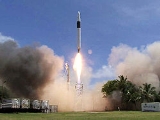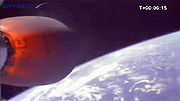
Falcon 1 Flight 4
Encyclopedia
Ratsat, was a 165-kilogram (363-pound) non-functional boilerplate spacecraft used as a mass simulator on the fourth flight of the Falcon 1
rocket. The non-functional payload was carried due to the Falcon 1 having failed on all of the three previous launches. The launch, identified as Falcon 1 Flight 4, was conducted by SpaceX
, and marked the first time the Falcon 1 rocket successfully achieved orbit.
Ratsat remained bolted to the second stage of the carrier rocket after reaching low Earth orbit
. It has a hexagonal prism
shape, 1.5 m (5 ft) long.
SpaceX co-founder Elon Musk
estimates that Ratsat will remain in orbit for between five and ten years before burning up in the atmosphere.
satellite. The test flight was introduced into the launch schedule because Astronautic Technology Sdn Bhd
(ATSB) required a successful flight to be conducted before RazakSAT could be launched.
The schedule left very little time for modifications and testing. The rocket was shipped to the company's testing facilities in Texas where, after less than 24 hours, it was certified for launch. SpaceX chartered a United States Air Force C-17
flight on 3–4 September to carry both stages of the rocket 9,700 km (6,000 mi) to the launch facilities at the Kwajalein Atoll. The Falcon 1 rocket was successfully test-fired on 20 September. Launch preparations on 23 September led the ground crew to replace part of a pipeline supplying liquid oxygen
to the second stage Kestrel engine. This work delayed the launch to 28 September.
 The launch occurred from Omelek Island
The launch occurred from Omelek Island
, part of the Kwajalein Atoll in the Marshall Islands
. Liftoff occurred at 23:15 UTC on 28 September, 15 minutes into a five-hour launch window. If the launch had been scrubbed, it could have been conducted during the same window until 1 October. Nine minutes and 31 seconds after launch, the second stage engine shut down, after the vehicle reached orbit. The initial orbit was reported to be about 330 x 650 km.
Following a coast period, the second stage restarted, and performed a successful second burn, resulting in a final orbit of 621 x 643 km x 9.35°.
It was Falcon 1's first successful launch, and the first successful orbital
launch of any privately-funded and developed
, liquid-propelled carrier rocket.
The rocket followed the same trajectory as the previous flight, which failed to place the Trailblazer
, NanoSail-D
, PreSat
and Explorers
spacecraft into orbit. No major changes were made to the rocket, other than increasing the time between first stage burnout and second stage separation. This minor change addressed the failure seen on the previous flight, recontact between the first and second stages, by dissipating residual thrust in the first stage engine before separating them.
Although SpaceX intended to recover the first stage of Falcon 1 launch vehicles, as of this launch, they had not yet succeeded in doing so. Stage recovery was a non-primary goal of the early flights. SpaceX is utilizing an incremental development process to work the design issues with stage recovery and CEO Elon Musk stated that the probability of a successful recovery would have increased with subsequent flights, however the Falcon 1 was subsequently retired from service after its fifth launch, with first stage recovery never having been accomplished successfuly.
Falcon 1
The Falcon 1 is a partially reusable launch system designed and manufactured by SpaceX, a space transportation company in Hawthorne, California. The two-stage-to-orbit rocket uses LOX/RP-1 for both stages, the first powered by a single Merlin engine and the second powered by a single Kestrel engine...
rocket. The non-functional payload was carried due to the Falcon 1 having failed on all of the three previous launches. The launch, identified as Falcon 1 Flight 4, was conducted by SpaceX
SpaceX
Space Exploration Technologies Corporation, or more popularly and informally known as SpaceX, is an American space transport company that operates out of Hawthorne, California...
, and marked the first time the Falcon 1 rocket successfully achieved orbit.
Ratsat remained bolted to the second stage of the carrier rocket after reaching low Earth orbit
Low Earth orbit
A low Earth orbit is generally defined as an orbit within the locus extending from the Earth’s surface up to an altitude of 2,000 km...
. It has a hexagonal prism
Hexagonal prism
In geometry, the hexagonal prism is a prism with hexagonal base. The shape has 8 faces, 18 edges, and 12 vertices.Since it has eight faces, it is an octahedron. However, the term octahedron is primarily used to refer to the regular octahedron, which has eight triangular faces...
shape, 1.5 m (5 ft) long.
SpaceX co-founder Elon Musk
Elon Musk
Elon Musk is an American engineer and entrepreneur heritage best known for co-founding PayPal, SpaceX and Tesla Motors. He is currently the CEO and CTO of SpaceX, CEO and Product Architect of Tesla Motors and Chairman of SolarCity...
estimates that Ratsat will remain in orbit for between five and ten years before burning up in the atmosphere.
Preparations
When the fourth flight was first announced in August 2008, shortly after the third flight failed, it was planned for launch in September. The rocket that was used to conduct the test flight was originally built to launch the RazakSATRazakSAT
RazakSAT is a Malaysian satellite carrying a high-resolution camera. It was launched into low Earth orbit by a Falcon 1 rocket on July 14, 2009. It was placed into a near-equatorial orbit that presents many imaging opportunities for the equatorial region.It weighs over three times a much as...
satellite. The test flight was introduced into the launch schedule because Astronautic Technology Sdn Bhd
Astronautic Technology Sdn Bhd
Astronautic Technology Sdn Bhd or better known as ATSB was established in 1997 and is wholly owned by the Minister of Finance Inc under the supervision of the Malaysian Ministry of Science, Technology and Innovation ....
(ATSB) required a successful flight to be conducted before RazakSAT could be launched.
The schedule left very little time for modifications and testing. The rocket was shipped to the company's testing facilities in Texas where, after less than 24 hours, it was certified for launch. SpaceX chartered a United States Air Force C-17
C-17 Globemaster III
The Boeing C-17 Globemaster III is a large military transport aircraft. Developed for the United States Air Force from the 1980s to the early 1990s by McDonnell Douglas, the C-17 is used for rapid strategic airlift of troops and cargo to main operating bases or forward operating bases throughout...
flight on 3–4 September to carry both stages of the rocket 9,700 km (6,000 mi) to the launch facilities at the Kwajalein Atoll. The Falcon 1 rocket was successfully test-fired on 20 September. Launch preparations on 23 September led the ground crew to replace part of a pipeline supplying liquid oxygen
Liquid oxygen
Liquid oxygen — abbreviated LOx, LOX or Lox in the aerospace, submarine and gas industries — is one of the physical forms of elemental oxygen.-Physical properties:...
to the second stage Kestrel engine. This work delayed the launch to 28 September.
Launch

Omelek Island
Omelek Island is part of the Kwajalein Atoll in the Republic of the Marshall Islands. It is controlled by the United States military under a long-term lease and is part of the Ronald Reagan Ballistic Missile Defense Test Site.-Geography:The Island is about in size...
, part of the Kwajalein Atoll in the Marshall Islands
Marshall Islands
The Republic of the Marshall Islands , , is a Micronesian nation of atolls and islands in the middle of the Pacific Ocean, just west of the International Date Line and just north of the Equator. As of July 2011 the population was 67,182...
. Liftoff occurred at 23:15 UTC on 28 September, 15 minutes into a five-hour launch window. If the launch had been scrubbed, it could have been conducted during the same window until 1 October. Nine minutes and 31 seconds after launch, the second stage engine shut down, after the vehicle reached orbit. The initial orbit was reported to be about 330 x 650 km.
Following a coast period, the second stage restarted, and performed a successful second burn, resulting in a final orbit of 621 x 643 km x 9.35°.
It was Falcon 1's first successful launch, and the first successful orbital
Geocentric orbit
A geocentric orbit involves any object orbiting the Earth, such as the Moon or artificial satellites. Currently there are approximately 2,465 artificial satellites orbiting the Earth and 6,216 pieces of space debris as tracked by the Goddard Space Flight Center...
launch of any privately-funded and developed
Private spaceflight
Private spaceflight is flight above Earth altitude conducted by and paid for by an entity other than a government. In the early decades of the Space Age, the government space agencies of the Soviet Union and United States pioneered space technology augmented by collaboration with affiliated design...
, liquid-propelled carrier rocket.
The rocket followed the same trajectory as the previous flight, which failed to place the Trailblazer
Trailblazer (satellite)
Trailblazer was a technology demonstration satellite, which was to have been operated by the United States Air Force and the Missile Defense Agency...
, NanoSail-D
NanoSail-D
NanoSail-D was a small satellite which was to have been used by NASA's Ames Research Center to study the deployment of a solar sail in space. It was a three-unit CubeSat measuring 30 by 10 by 10 centimetres , with a mass of...
, PreSat
PREsat
The PharmaSat Risk Evaluation nanosatellite was about the size of a loaf of bread, weighed about 10 pounds and was constructed in just six months...
and Explorers
Celestis
Celestis is a company that launches cremated human remains into space, a procedure known as a space burial. It is an affiliate company of Space Services Inc. The company purchases launches as a secondary payload on various rockets, and launches samples of many peoples' cremated remains on one launch...
spacecraft into orbit. No major changes were made to the rocket, other than increasing the time between first stage burnout and second stage separation. This minor change addressed the failure seen on the previous flight, recontact between the first and second stages, by dissipating residual thrust in the first stage engine before separating them.
Although SpaceX intended to recover the first stage of Falcon 1 launch vehicles, as of this launch, they had not yet succeeded in doing so. Stage recovery was a non-primary goal of the early flights. SpaceX is utilizing an incremental development process to work the design issues with stage recovery and CEO Elon Musk stated that the probability of a successful recovery would have increased with subsequent flights, however the Falcon 1 was subsequently retired from service after its fifth launch, with first stage recovery never having been accomplished successfuly.
See also
- 2008 in spaceflight2008 in spaceflightThe year 2008 contained several significant events in spaceflight, including the first flyby of Mercury by a spacecraft since 1975, the discovery of water ice on Mars by the Phoenix spacecraft, which landed in May, the first Chinese spacewalk in September, and the launch of the first Indian Lunar...

